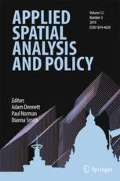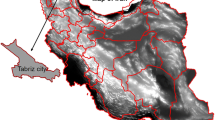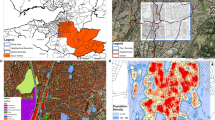Abstract
There has been an extensive tradition of geographical studies7 conducted to analyse the access to urban parks or green spaces. Several studies deploy approaches to measure the potential spatial accessibility and congestion of children’s playgrounds in urban areas. Identifying inequalities in terms of spatial access to children’s playgrounds is an important issue that could be useful for urban planners. The main objective of this paper is to measure the potential spatial accessibility and congestion of playgrounds in Barcelona City. A second objective is to analyse the factors that may explain differences between neighbourhoods in spatial access to playgrounds. Several analyses were carried out. First, two indicators of spatial potential accessibility are computed at the census tract level. Next, a mapping technique is used based on a cross tabulation of the quintiles of two indicators. A typology of census tracts can then be developed according to the various possible combinations between playground accessibility and congestion. Third, two spatial models—spatial lag and spatial error—are estimated in order to introduce socioeconomic factors into the explanation of accessibility and congestion. Finally, a multinomial logistic model is estimated to explain the typology of Barcelona census tracts based on potential playground congestion and accessibility. The results show that in Barcelona City, there are no important spatial disparities in terms of access to children’s playgrounds.




Similar content being viewed by others
References
Akçagün, P. (2017). Provincial growth in Turkey: A spatial econometric analysis. Applied Spatial Analysis and Policy, 10(2), 271–299.
Albert, G., Abo-Kalla, H., & Baron, M. (2011). Transport and environmental variables and the impact of cultural differences on playground use. Journal of Urban Planning and Development, 137(3), 291–297.
Anselin, L. (2002). Under the hood issues in the specification and interpretation of spatial regression models. Agricultural Economics, 27(3), 247–267.
Anselin, L, and RJGM Florax. 1995. “Small sample properties of tests for spatial dependence in regression models: Some further results.” In New Directions in Spatial Econometrics. Springer 21–74.
Apparicio, P., Cloutier, M.-S., Séguin, A.-M., & Ades, J. (2010). Accessibilité Spatiale Aux Parcs Urbains Pour Les Enfants et Injustice Environnementale. Exploration Du Cas Montréalais. Revue Internationale de Géomatique, 20(3), 363–389.
Apparicio, P., Pham, T. T. H., Séguin, A. M., & Dubé, J. (2016). Spatial distribution of vegetation in and around City blocks on the island of Montreal: A double environmental inequity? Applied Geography, 76, 128–136.
Arraiz, I., Drukker, D. M., Kelejian, H. H., & Prucha, I. R. (2010). A spatial cliff and Ord type model with heteroskedastic innovations: Small and Lartge sample results. Journal of Regional Science, 50(2), 592– 614.
Bayona-i-Carrasco, J., & Pujadas-i-Rúbies, I. (2014). Movilidad Residencial Y Redistribución de La Población Metropolitana: Los Casos de Madrid Y Barcelona. EURE (Santiago), 40(119), 261–287.
Bennet, S. A., Yiannakoulias, N., Williams, A. M., & Kitchen, P. (2012). Playground accessibility and Neighbourhood social interaction among parents. Social Indicators Research, 108, 199–213.
Bivand, R., & Piras, G. (2015). Comparing implementations of estimation methods for spatial econometrics. Journal of Statistical Software, 63(18), 1–36.
Bivand, R., Hauke, J., & Kossowski, T. (2013). Computing the Jacobian in Gaussian spatial autoregressive models: An illustrated comparison of available methods. Geographical Analysis, 45(2), 150–179.
Boone, C., Geoffrey. L. B., Morgan J. G., & Sister, C. (2009). Parks and people: An environmental justice inquiry in Baltimore, Maryland. Annals of the Association of American Geographers, 99(4), 767–787.
Brasington, David M, and Diane Hite. 2005. “Demand for Environmental Quality: A Spatial Hedonic Analysis.” Regional Science and Urban Economics 35 (1). Elsevier: 57–82.
Casetti, E. (1972). Generating models by the expansion method: Applications to geographic research. Geographical Analysis, 28, 281–298.
Dewi, S. P. (2012). How does the playground role in realizing children-Friendly-City? Procedia - Social and Behavioral Sciences, 38, 224–233.
Dietze, B. (2013). How accessible and usable are our Neighbourhood playgrounds for children who have mobility restrictions or use mobility devices? Canadian Children, 38(2), 14–20.
Fjortoft, I. (2001). The natural environment as a playground for children: The impact of outdoor play activities in pre-primary school children. Early Childhood Education Journal, 29(2), 111–117.
Giles-Corti, B., Timperio, A., Bull, F., & Pikora, T. (2005). Understanding physical activity environmental correlates: Increased specificity for ecological models. Exercise and Sport Sciences Reviews, 33(4), 175–181.
Kaczynski, A. T., & Henderson, K. A. (2007). Environmental correlates of physical activity: A review of evidence about parks and recreation. Leisure Sciences, 29(4), 315–354.
Kryvobokov, M., Bonnafous, A., & Bouf, D. (2015). Simulating residential location choice at different geographical scales: The case of Lyon. Applied Spatial Analysis and Policy, 8(4), 351–370.
LeSage, J. P., & Pace, R. K. (2009). Introduction to spatial econometrics. Boca Raton: CRC Press.
Luo, W., & Qi, Y. (2009). An enhanced two-step floating catchment area (E2SFCA) method for measuring spatial accessibility to primary care physicians. Health and Place, 15, 1100–1107.
Martori, J. C., & Apparicio, P. (2011). Changes in spatial patterns of the immigrant population of a southern European Metropolis: The case of the Barcelona metropolitan area (2001-2008). Tijdschrift voor Economische en Sociale Geografie, 102(5), 562–581.
Martori, J. C., Madariaga, R., & Oller, R. (2016). Real estate bubble and urban population density: Six Spanish metropolitan areas 2001–2011. Annals of Regional Science, 56(2), 369–392.
McCarthy, S. M., Morgan Hughey, S., & Kaczynski, A. T. (2017). Examining sociodemographic differences in playground availability and quality and associations with childhood obesity. Childhood Obesity, 13(4), 1–8.
Moore, R. C., & Cosco, N. G. (2010). Using behaviour mapping to investigate healthy outdoor environments for children and families: Conceptual framework, procedures and applications. In In Innovative Approaches to Research Excellence in Landscape and Health. London: Taylor & Francis.
Moore, A., & Lynch, H. (2015). Accessibility and usability of playground environments for children under 12: A scoping review. Scandinavian Journal of Occupational Therapy, 22(5), 331–344.
Ngom, R., Gosselin, P., & Blais, C. (2016). Reduction of disparities in access to green spaces: Their geographic insertion and recreational functions matter. Applied Geography, 66, 35–51.
Ngui, A. N., & Apparicio, P. (2011). Optimizing the two-step floating catchment area method for measuring spatial accessibility to medical clinics in Montreal. BMC Health Services Research, 11, 166.
Olsen, Heather M., and Rodney B. Dieser. 2012. “I am hoping you can point me in the right direction regarding playground accessibility”: A case study of a community which lacked social policy toward playground accessibility.” World Leisure Journal 54(3): 269–79.
Prellwitz, M., & Skär, L. (2007). Usability of playgrounds for children with different abilities. Occupational Therapy International, 14(3), 144–155.
Prellwitz, M., Tamm, M., & Lindqvist, R. (2001). Are playgrounds in Norrland (northern Sweden) accessible to children with restricted mobility? Scandinavian Journal of Disability Research, 3(1), 56–68.
Reyes, M., Páez, A., & Morency, C. (2014). Walking accessibility to urban parks by children: A case study of Montreal. Landscape and Urban Planning, 125, 38–47.
Rigolon, A. (2016). A complex landscape of inequity in access to urban parks: A literature review. Landscape and Urban Planning, 153, 160–169.
Ripat, J., & Becker, P. (2012). Playground usability: What do playground users say? Occupational Therapy International, 19, 144–153.
Roemmich, J. N., Beeler, J. E., & Johnson, L. A. (2014). A microenvironment approach to reducing sedentary time and increasing physical activity of children and adults at a playground. Preventive Medicine, 62, 108–112.
Sister, C., Wolch, J., & Wilson, J. P. (2010). Got green? Addressing environmental justice in park provision. Geo Journal, 75(3), 229–248.
Siu, K. W. M., Wong, Y. L., & Lam, M. S. (2017). Inclusive play in urban cities: A pilot study of the inclusive playgrounds in Hong Kong. Procedia Engineering, 198(September 2016), 169–175.
Smiley, K. T., Sharma, T., Steinberg, A., Hodges-Copple, S., Jacobson, E., & Matveeva, L. (2016). More inclusive parks planning. Environmental Justice, 9(1), 1–7.
Smoyer-Tomic, K. E., Hewko, J. N., & John Hodgson, M. (2004). Spatial accessibility and equity of playgrounds in Edmonton, Canada. Canadian Geographer, 48(3), 287–302.
Talen, E., & Anselin, L. (1998). Assessing spatial equity: An evaluation of measures of accessibility to public playgrounds. Environment and Planning A, 30, 595–613.
Tamm, M., & Prellwitz, M. (1999). Attitudes of key persons to accessibility problems in playgrounds for children with restricted mobility: A study in a medium-sized municipality in northern Sweden. Scandinavian Journal of Occupational Therapy, 6(4), 166–173.
Tang, B. S. (2017). Explaining the inequitable spatial distribution of public open space in Hong Kong. Landscape and Urban Planning, 161, 80–89.
Turner, J., Fralic, J., Newman-Bennett, K., & Skinner, L. (2009). Everybody needs a break! Responses to a Playgarden survey. Pediatric Nursing, 35(1), 27–61134.
Venables, W. N., & Ripley, B. D. (2002). Modern Applied Statistics with S. fourth. New York: Springer.
Veugelers, P., Sithole, F., Zhang, S., & Muhajarine, N. (2008). Neighborhood characteristics in relation to diet, physical activity and overweight of Canadian children. International Journal of Pedistric Obesity, 3, 152–159.
Wen, M., Zhang, X., Harris, C. D., Holt, J. B., & Croft, J. B. (2013). Spatial disparities in the distribution of parks and green spaces in the USA. Annals of Behavioral Medicine, 45(S1), 18–27.
Wolch, J., Wilson, J. P., & Fehrenbach, J. (2005). Parks and park funding in Los Angeles: An equity-mapping analysis. Urban Geography, 26(1), 4–35.
Acknowledgements
The authors gratefully thank Rafa Madariaga for his valuable suggestions on previous drafts of the paper. Angels Pinyana proof read fruitfully the paper. We also thank the Data Analysis and Modeling research group (2017SGR71) for the fruitful discussions we held together. We would like to thank the two reviewers and the Editor for very helpful improvement suggestions.
Author information
Authors and Affiliations
Corresponding author
Ethics declarations
Conflict of Interest
The authors declare that they have no conflict of interest.
Additional information
Publisher’s Note
Springer Nature remains neutral with regard to jurisdictional claims in published maps and institutional affiliations.
Rights and permissions
About this article
Cite this article
Martori, J.C., Apparicio, P. & Séguin, AM. Spatial Potential Accessibility of Playgrounds in Barcelona City. Appl. Spatial Analysis 13, 489–506 (2020). https://doi.org/10.1007/s12061-019-09316-4
Received:
Accepted:
Published:
Issue Date:
DOI: https://doi.org/10.1007/s12061-019-09316-4




